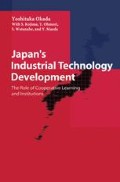Abstract
Technological development is one of the major factors accounting for Japan’s rapid industrial development from the ruins of war to second place in the world. It is reported that market competition in Japan is severe and that firms stress technology in their competitive strategies. But government has played a role in spurring firms to advance from innovative imitation to radical innovation. Policy goals have changed over the decades, from support for technology import in the 1950s, to technology development in the 1960s, to radical innovation since the 1970s. In the 1980s the government stressed technological development as the life line of the economy.
Access this chapter
Tax calculation will be finalised at checkout
Purchases are for personal use only
Preview
Unable to display preview. Download preview PDF.
References
Aichlken Shokobu (Commerce and Industry Section, Aichi Prefectural Government) (1992). Kenkyu Koryu Sisutemuka Chosa: Kyodo Kenkyu Shisaku Jirei Shu (Study on Research Interaction System: Cooperative Research Examples). Nagoya: Aichiken Shokobu.
Brock, Malcolm V. (1989). Biotechnology in Japan. N.Y.: Routledge.
Chusho Kigyo Cho (Small and Medium Enterprise Agency) (1992). Chusho Kigyo Shisaku no Aramashi (Overall Guidelines of Government Policies for Small- and Medium-Sized Firms). Tokyo: Chusho Kigyo Sogo Kenkyu Kiko.
Chusho Kigyo Cho Gijyutsuka (Small and Medium Enterprise Agency Technology Section) (1993). Gijyutsu no Suketto Kosetsushi (Technology Helper Kosetsushi).Tokyo: Doyukan.
Cusumano, Michael A. (1993). Nihon no Sofuto Uea Senryaku (Japan’s Software Strategies). Tokyo: Mita Publisher.
Fransman, Martin (1990). The Market and Beyond: Cooperation and Competition in Information Technology Development in the Japanese System. Cambridge: Cambridge University Press.
Goto, Akira (1993). Nihon no Gijyutsu Kakushin to Sangyo Soshiki (Japanese Technological Innovation and Industrial Organization). Tokyo: University of Tokyo Press.
Goto, Akira and Wakasugi, Ryuhei (1988). “Technology Policy.” In Ryutaro Komiya, Masahiro Okuno, and Kotaro Suzumura. Eds. Industrial Policy of Japan. N.Y.: Academic Press. Pp. 183–205.
Imai, Kenichi (1986). “Japan’s Industrial Policy for High Technology Industry.” In Hugh Patrick. Ed. Japan’s High Technology Industries. Seattle: University of Washington Press. Pp. 137–170.
Ito, Daiichi (1991). “Government-Industry Relations in a Dual Regulatory Scheme: Engineering Research Associations as Policy Instruments.” In Stephen Wilks and Maurice Wright. Eds. The Promotion and Regulation of Industry in Japan. London: Macmillan Academic and Professional Ltd. Pp. 51–80.
Johnson, Bjorn (1992). “Institutional Learning.” In Bengt-Ake Lundvall. Ed. National Systems of Innovation: Toward ATheory of Innovation and Interactive Learning. London: Printer Publishers. Pp. 23–44.
Johnson, Chalmers (1982). MITI and the Japanese Miracle. Stanford, Calif.: Stanford University Press.
Kagaku Gijyutsu Seisakushi Kenkyukai (Study Group on Science and Technology Policy History) (1990). Nihon no Kagaku Gijyutsu Seisaku Shi (History of Japanese Science and Technology Policy). Tokyo: Mitoh Kagaku Gijyutsu Kyokai.
Kato, Makoto; Mizuno, Takeshi; and Kobayashi, Yasuo. Eds. (1977). Soshiki Mondai to Chushokigyo (Organizational Problems and Small- and Medium-Sized Firms). Tokyo: Doyukan.
Kodama, Fumio (1991). Haiteku Gijyutsu no Paradaimu (Paradigm in High Technology). Tokyo: Chuo Koronsha.
Moritani, Masanori (1986). Gijyutsu Kaihatsu no Showashi (History of Technology Development in Showa Period). Tokyo: Toyo Keizai Shinposha.
Okada, Yoshitaka (1990). Technological Development and Growth of Japanese Integrated Circuit Firms: an Exploratory Study. Center for Japan-U.S. Relations Working Paper No. 5. International University of Japan.
Okada, Yoshitaka (1993). “Institutional Arrangements and Japanese Competitive-cum-Cooperative System of Production.” A paper presented at the Conference on “The Social System of Production,” held at St. John’s College at Cambridge University, Cambridge, England, on September 23–26.
Okimoto, Daniel I. (1986). “Regime Characteristics of Japanese Industrial Policy.” In Hugh Patrick. Ed. Japan’s High Technology Industries. Seattle: University of Washington Press. Pp. 35–95
Saito, Masaru (1988). Gijyutsu Kaihatsuron: Nihon no Gijyutsu Kaihatsu Mekanizumu to Seisaku (Study of Technology Development: Mechanism of Japanese Technological Development and Policies). Tokyo: Bunshindo.
Sigurdson, Jon and Anderson, Alun M. (1991). Science and Technology in Japan. Essex, U.K.: Longman Group UK Ltd.
Tatsuno, Sheridan M. (1991). “Building the Japanese Techno-State: The Regionalization of Japanese High Tech.” In Ulrich Hilpert. Ed. Regional Innovation and Decentralization: High Tech Industry and Government Policy. London: Routledge. Pp. 219–235.
Tokyo Maruami Meriyasu Kogyo Kumiai (Tokyo Round-Neck Knitting Goods Industry) (1974). Tokyo Maruami Meriyasu Sangyo Shi (History of Round-Neck Knitted Goods in Tokyo). Tokyo: Tokyo Maruami Meriyasu Kogyo Kumiai.
Wada, Masateke (1994). “Role of Technology Supporting Institutions in Technological Innovation in the Japanese Software Industry.” A paper submitted to the World Bank for “Policy and Institutional Priorities for Industrial Technology Development” project. May.
Wakasugi, Ryuhei (1986). Gijyutsu Kakushin to Kenkyu Kaihatsu no Keizai Bunseki (Economic Analyses of Technological Innovation and R&D Activities). Tokyo: Toyo Keizai Shinposha.
Williamson, Oliver (1975). Markets and Hierarchies: Analysis and Antitrust Implications. New York: The Free Press.
Williamson, Oliver (1985). The Economic Institution of Capitalism. New York: The Free Press.
Author information
Authors and Affiliations
Editor information
Editors and Affiliations
Rights and permissions
Copyright information
© 1999 Springer-Verlag Tokyo
About this chapter
Cite this chapter
Okada, Y. (1999). Cooperative Learning and Technological Development in Japan. In: Okada, Y. (eds) Japan’s Industrial Technology Development. Springer, Tokyo. https://doi.org/10.1007/978-4-431-68509-8_2
Download citation
DOI: https://doi.org/10.1007/978-4-431-68509-8_2
Publisher Name: Springer, Tokyo
Print ISBN: 978-4-431-70265-8
Online ISBN: 978-4-431-68509-8
eBook Packages: Springer Book Archive

